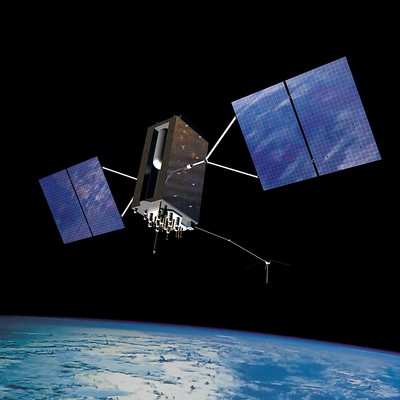First Launch Planned for 2014
 A key requirements review for the
Global Positioning System (GPS) IIIB satellite series under the
U.S. Air Force's next generation GPS III Space Segment program has
been successfully completed, according to contractor Lockheed
Martin. The company says GPS III will improve position, navigation
and timing services and provide advanced anti-jam capabilities
yielding superior system security, accuracy and reliability for
users around the globe.
A key requirements review for the
Global Positioning System (GPS) IIIB satellite series under the
U.S. Air Force's next generation GPS III Space Segment program has
been successfully completed, according to contractor Lockheed
Martin. The company says GPS III will improve position, navigation
and timing services and provide advanced anti-jam capabilities
yielding superior system security, accuracy and reliability for
users around the globe.
Lockheed Martin Space Systems of Newtown, PA, is working under a
$3 billion Development and Production contract to produce up to 12
GPS IIIA satellites, with first launch projected for 2014. The
contract, which features a "back to basics" acquisition approach to
low-risk constellation sustainment and technology insertion,
includes a Capability Insertion Program (CIP) designed to mature
technologies and perform rigorous systems engineering for the
future IIIB and IIIC increments planned for follow-on
procurements.
In a Monday news release, the company says it recently completed
a two-day GPS IIIB System Requirements Review (SRR) with the U.S.
Air Force at Lockheed Martin's facilities in Valley Forge, PA. Over
170 attendees participated in the SRR, including representatives
from the U.S. Air Force's GPS Wing, Air Force Space Command, the
Defense Contract Management Agency, the OCX Ground Segment team,
the Federal Aviation Administration and user communities.
"The GPS IIIB SRR was a success," said Lt. Col. Don Frew, GPS
III Squadron Commander. "Lockheed Martin demonstrated to the
government that the team is working to a solid requirements
baseline and developing a mature design beyond what we normally see
at a SRR. I want to thank the GPS III team for all their hard work
and dedication."
The successful review demonstrated to the customer and user
community the Lockheed Martin team's understanding of the inherent
product development and technology maturity risks, how they will be
met, and the program's readiness to continue to the GPS IIIB System
Design Review.

GPS Satellite Artist's Rendering
"This important review effectively demonstrated our technology
advancement and orderly, low-risk transition plan for meeting our
customer's performance objectives," said John Frye, Lockheed
Martin's manager of the GPS III Capability Insertion Program. "We
are laser focused on executing to the baseline requirements in
place for GPS IIIB while implementing the systems engineering
processes necessary to accommodate change as GPS IIIB and GPS IIIC
evolve."
The GPS IIIA satellites will deliver significant improvements
over current GPS space vehicles, including a new international
civil signal (L1C) and increased M-Code anti-jam power with full
earth coverage for military users.
GPS IIIB will enable a cross-linked command and control
architecture, allowing these GPS III vehicles to be updated from a
single ground station instead of waiting for each satellite to
orbit in view of a ground antenna. GPS IIIC will include a
high-powered spot beam to deliver greater M-Code power for
increased resistance to hostile jamming.
The team, which is progressing in the GPS IIIA Critical Design
Review (CDR) phase of the program, has completed more than 80
percent of the planned CDRs and is well on its path to the overall
space vehicle CDR in August, two months ahead of the planned
schedule. Successful completion of the space vehicle CDR will allow
the team to enter the production phase of the program.
 Sierra Space Repositions Dream Chaser for First Mission
Sierra Space Repositions Dream Chaser for First Mission ANN's Daily Aero-Term (05.10.24): Takeoff Roll
ANN's Daily Aero-Term (05.10.24): Takeoff Roll Aero-News: Quote of the Day (05.10.24)
Aero-News: Quote of the Day (05.10.24) Aero-News: Quote of the Day (05.11.24)
Aero-News: Quote of the Day (05.11.24) ANN's Daily Aero-Term (05.11.24): IDENT Feature
ANN's Daily Aero-Term (05.11.24): IDENT Feature




